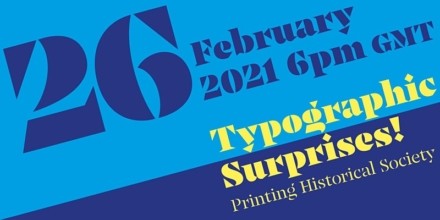First in the Printing Historical Society‘s new Typographic Surprises! webinar series.
A look at lesser-known aspects of print’s past, typographic archives and printed collections.
Fri, 26 February 2021
19:00 – 21:00 CET
Register free
Dr Alexandra Franklin
A surprising journey to the third dimension
Librarians make every effort to keep things flat. When is it OK to go 3D? We will take a behind-the-scenes and inside-the-lines look at often-neglected collections of printing surfaces in one library, the Bodleian in Oxford. These testify to the three-dimensional history and nature of the printed page.
Alexandra is Co-ordinator of the Bodleian Libraries Centre for the Study of the Book and the Bodleian Bibliographical Press. She is the author of ‘Woodcuts,’ in Book Parts (2019) and of ‘Casting Off: a journey in five starts,’ in the journal Inscription 1, 2020.
Patrick Goossens
What came after punch cutting
At the outset of printing in the west it is (almost) generally accepted that type was made via a steel punch driven in a copper matrix. The advent of the nineteenth, with its hankering for speed, efficiency and de-skilling, brought new technologies to the old trade. Pantographic punch and matrix cutting was one of them. Patrick will take us inside his Antwerp engraving room for a look at some of the different punch and matrix engraving equipment he has gathered over the last decades with a briefly explanation and demonstration of the processes.
Born in Antwerp, the home-town of the Plantin-Moretus Museum, Patrick studied history at the University Antwerp and Louvain. Mesmerised by the Museum’s press room he started to collect and research historical printing and typecasting equipment. This collection has allowed him to research the tangible and intangible sides of printing history for his ongoing doctoral thesis on the dissemination of innovative printing technology in the nineteenth century, focusing on Belgium. Patrick has presented some of his preliminary findings, worldwide.
Martin Killeen
What is the use of a book without pictures?
This presentation will provides some perspectives on the illustration of early printed books including a brief comparison of the relatively few illustrated books of native literature published in England before 1700 compared to Continental Europe, especially Italy.
Martin Killeen, recently retired Rare Books Librarian at the Cadbury Research Library, spent more than thirty years exploiting the rich resources of the repository (printed books, archives and manuscripts) to support teaching, learning and research across all the disciplines within the University and beyond. This included delivering talks and presentations and using original materials to lead seminars and classes (which often cover themes relating to print and publishing history and physical bibliography). Martin also publishes papers based on the Cadbury Research Library’s holdings.
